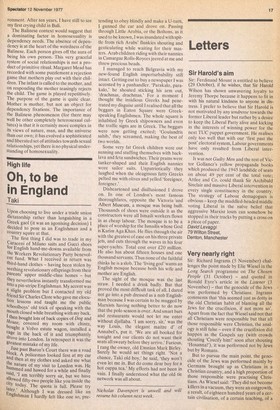A hell for homosexuals
Max Harris
Bali Bali is a paradisical island that lives up to every Hollywood cliché. Both the people and the island offer an almost painful ravishment of the senses. Bali is unspoiled, its native culture uncontaminated, despite being stomped over by constant armies of tourists. Social and anthropological studies since the war have confirmed this startling immunity to the impact of tourism.
Hindu-animism has made the Balinese a closed and aristocratic community, highly tribalised, and not at all motivated to move beyond the sparse subsistence standards of a rice-crop economy. In any case, the world stops beyond Bali, which is believed to exist on the back of a deified turtle, and there's an element of untouchable diabolism about the ugly pink-skinned visitors from other worlds.
But the most curious fact I have unearthed about the two and a half million Balinese is that they have never heard of nor bothered to invent homosexuality. There is no word for it in any of the pure Balinese languages. Surprisingly, there is very little anthropological literature investigating this remarkable aspect of Balinese sexuality. The Dutch didn't concern themselves with such a repulsive subject and from Margaret Mead onwards the theme has commanded little interest, presumably because the phenomenon didn't and doesn't exist.
For all I know there may be numerous other more primitive societies which haven't thought up homosexuality as a mode of sexual expression. But there is a highly developed sophistication in the sexual culture of the Balinese. There is an absence of repressions and prohibitions that were once central to the Western Christian tradition, The universal folkloric material of the Balinese, the Ramayana, is an epic with a great deal of subtlety in its presentation of sacred and profane love. The Balinese have few observable sexual hangups. They make very little fuss about sexuality. If children see their parents making love, so be it.
I tend to think the Balinese possess such a liberated and sophisticated society that they place only a very moderate emphasis on sexuality. It is a preoccupation less demanding than gamelan music, legong dancing, funeral festivities, offerings to the rice goddess, and cock-fighting. Sexuality is viewed as a natural appetite, and somewhat comic at that.
In other words, any careful study of the Balinese indicates that there would be no social or religious objections to homosexuality, if the idea had ever occurred to any one. But it hasn't. Physical contact is natural to the Balinese, and it is perfectly common to see young men or young ladies holding hands. It is hard to believe that this never leads to anything, but it doesn't. For the cruising European or Japanese homosexual Bali is a sort of special hell. The most physically beautiful people on earth, and not one of them with a clue about the codes and signals of the homosexual freemasonry.
How can l support this claim that Bali is a totally non-homosexual society? It is impossible to adduce formal scientific evidence that homosexuality does not exist. But on balance it has proved more difficult to adduce evidence that it does exist.
The only continuous field investigators of the Balinese, going back to the Dutch occupation, are the missionary workers from the Society of the Divine Word — a tough Catholic organisation which tends to go native since the Balinese are unconvertible except on their own flamboyantly ritualistic terms. After decades in the field, old Father Shattuck knows of no village homosexuality. Father Anibal Oprandi, an Argentinian worker-priest with thirteen years of close intimacy with villagers all over the island, has found that homosexuality is not suppressed; it is just not comprehended. The same view is taken by the septuagenarian bishop of the diocese, the oldest hand of the Indonesian islands, and a world-class anthropologist, Educated Javanese tell a similar story. The Balinese, they declare, are a very stupid people. Because they are sexually casual, they have been known to submit to homosexual1 blandishments from Europeans because they think it courteous to indulge the eccentricies of the outsiders. But amongst themselves — never. Whereas little is known about the sexual psychology of the Balinese, a great deal of research has gone into their social organisation. The total heterosexuality of a huge and crowded nation is probably explained by the shapeless and yet wholly effective mechanism of the unique Balinese extended family. The welfare of children is the shared responsibility of all living within the sometimes extremely large family compounds.
Balinese children are never struck or otherwise ill-treated. Balinese children are not given toys (except the kite) and they don't seem to have much sense of organised games-playing. Their play is a mimicking of all the surrounding adult chores ancl activities. It has often been noted that the combination of extended communal family living, with a mandatory group responsibility for children, has produced in the Balinese an almost perfect childhood envi ronment. After ten years, I have still to see my first crying child in Bali.
The Balinese context would suggest that a dominating factor in homosexuality is dependency needs. The absence of dependency is at the heart of the weirdness of the Balinese. Each person gives off the aura of being his own person. This very graceful System of social relationships is not a product of primitive ritual. Margaret Mead has recorded with some puzzlement a rejection game that mothers play out with their children. The infant is called to the mother, and on responding the mother teasingly rejects the child. The game is played repetitively. The purpose of the game is quite clear. Mother is mother, but not an object for dependency fixations. The importance of the Balinese phenomenon (for there may well be other completely heterosexual cultures) is that it is certainly more complex in its views of nature, man, and the universe than our own; it has evolved a sophisticated and liberated set of attitudes towards sexual relationships, yet there is no physical understanding of homosexuality.



































 Previous page
Previous page